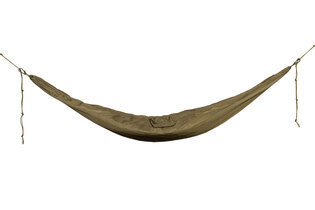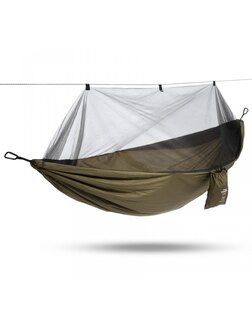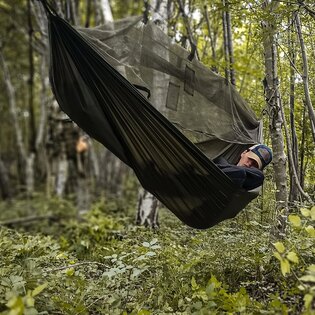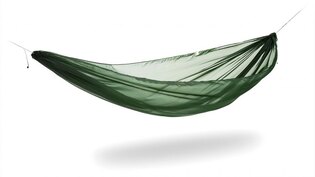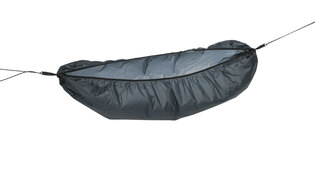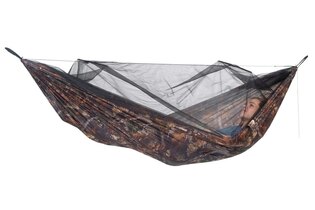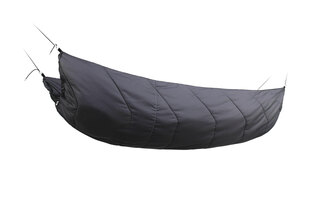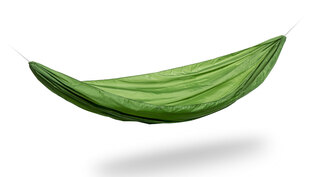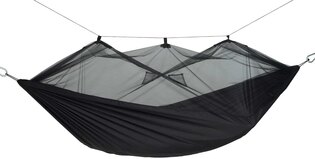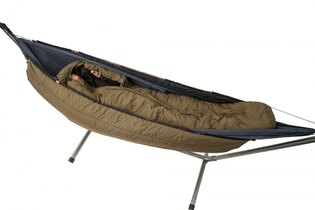How to properly hang a hammock
Whether you're planning to just enjoy some moments of free peace / time with friends or family, or you're heading to the forest for a longer event, you'll first need to learn how to properly tie your new hammock. Fortunately, most come with such a simple picture guide that even your dog would understand it. But that's only one part of the problem; it's also important to choose the right place for optimal hanging.

Sleeping in a hammock has its charm and advantages (you set it up in a few minutes instead of a few hours like a proper shelter, you can sleep even in swamps, ...), but for a person used to a flat and non-giving sleeping pad, it can be a shock. Moreover, some things simply can't be done in it – for example, you definitely won't fall asleep on your stomach in a hammock.
Since a hammock doesn't require cleaning the ground and surroundings and practically no pegs, a hammock is definitely the type of outdoor shelter that has one of the smallest impacts on nature and surroundings. When you use it with a hanging system that respects the trees and doesn't damage them, a hammock is probably the most natural way to be in nature unseen and with minimal impact around.
People who build a hammock camp (or just hang it for the day) follow these 3 very simple rules:
- Choose the right place for your hammock: apply the principle of 'no trace around' as much as possible. For example, don't place it too close to a water source, use a place and style that doesn't damage the trees, and it's also good to check under and around the hammock to make sure you don't fall onto any dangerous rocks or other objects.
- Use the right trees and wide straps: this means no dead trees around and no dead branches (similarly around). There shouldn't be any nest / habitat of anything rare that you will clearly disturb (building on a high expressway).
- Choose the right height (40-50 cm off the ground) and the optimal angle (about 30° between the ground and the strap) for hanging the hammock.
Where to ideally hang a hammock?
The usual camping principles apply here as well, so the same applies to 'hammocking outside' or sleeping in a hammock under the open sky. Then follow these four rules:
- Check with the landowners (local laws) if it is allowed to hang a hammock on a certain type of land. Not every place and state allows it. However, their popularity is growing, and if you hang your hammock in a very responsible way, there shouldn't be problems in the future either. Respect nature, that always applies.
- Hang your hammock at least 70-80 meters from a water source. Even though it's tempting to hang it near a lake or stream, by doing so you're disturbing the so-called protective zones (Riparian zone / habitat) along the banks, areas with blooming plants, trees, and animals. These are very sensitive areas and are still being destroyed today by people who don't respect this zone.
- When you find potential candidates for hanging your hammock, inspect them very carefully. Look for anything rare on the trees and under them. Also, watch out for wasp nests, poisonous plants, fungi, ... It's also good practice to go to places where someone has already walked and camped because when you do this, you only trample half of the land compared to if you went wherever you want. Avoiding dense vegetation with thorns (and not needing to clear it) will certainly improve the experience for you too.
- Never hang a hammock across a path used by people and animals. It can potentially have negative impacts on both sides. You won't sleep well, and you might provoke animals / get tangled in the net in the dark and panic. Also, don't put it in places with a logical path leading to water. If you're away for a long time, it's not a bad idea to take down the hammock so that nothing gets caught in it unnecessarily. However, if you have something on it (tarp) and it doesn't look like a bird net, and you're off the beaten path, it shouldn't be a problem...

One of the big advantages of a hammock is that it can be hung practically anywhere in the world where you find yourself – a few apple trees in your garden are just as good as pipes and poles in civilization. If you manage to sleep and rest in such a situation, you have our undying admiration!
Why is it necessary to choose the right trees and straps for the hammock?
Your optimal distance for hanging the hammock depends on its size, length, and design. After a few setups in different places, you will undoubtedly also observe what works for you. But there are other things besides the distances between trees to consider:
- Don't hang your hammock on unhealthy trees or branches. You could injure yourself, your dog, friends, or the surrounding ecosystem if the tree you chose gives way. Trees should also be robust enough (12-15 cm is ideal).
- Always use tree-safe straps. A sharp rope or Paracord type rope will cut into 75% of the tree's bark and most likely kill it. Therefore, it's necessary to use the widest straps possible (at least 2-3 cm). It doesn't matter whether they are made of polyester or nylon. The flatter, the better. Never use wire or steel cable. Also, don't hammer or screw anything into the tree.
- Reduce tree stress by using a different tree for each strand. Also, more people shouldn't use the same trees. An individual (small) impact on nature should always be as broad as possible.
Even though multiple hammocks placed above each other look interesting, it is a setup that burdens the trees. And you also risk a painful fall from higher levels, which will also affect those below.
How to hang your hammock at the right height and angle?
The following tips should suit most people. However, make sure to read the attached guide if you're unsure. It can be stated that anything that feels comfortable when you finally get into the hammock is acceptable, so go ahead and sleep like that. No need to carry a protractor and tape measure with you!
- Try to have a 30-degree angle between the strap and the ground. Even though it might be tempting to tension the hammock as much as possible (we humans are used to a perfectly flat sleeping surface at home), this creates pressure on the sides, which will likely feel restrictive when you turn. Try it for yourself and see what specific angle works for you with each hammock.
- Hang your hammock at the right height (40-50 cm off the ground). When the lowest point of your hammock (when you're already in it) is at this height, getting in and out is still very easy. Plus, if you fall from this height, you should survive without any injury.
- Sleep in your hammock a bit diagonally. What is meant by this and why? It solves the problem of the uncontrolled slight backward bending of the back, which happens in a hammock. But if you move your body about 10-15° off the center line once inside, you'll be lying in a more horizontal position.
Readers are further interested








































































































































